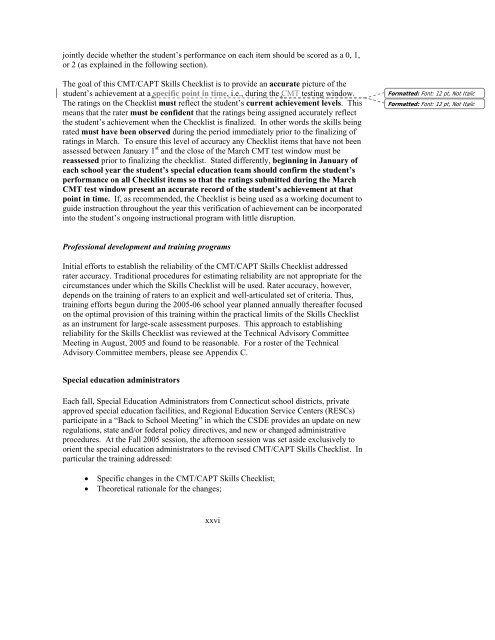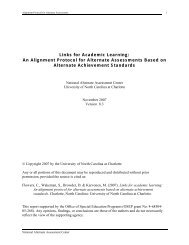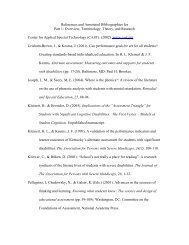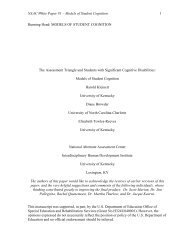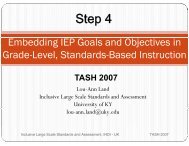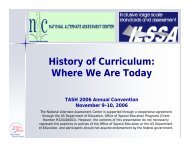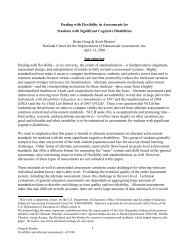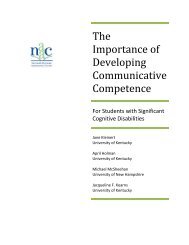CMT-CAPT Skills Checklist Technical Manual. - NAAC
CMT-CAPT Skills Checklist Technical Manual. - NAAC
CMT-CAPT Skills Checklist Technical Manual. - NAAC
Create successful ePaper yourself
Turn your PDF publications into a flip-book with our unique Google optimized e-Paper software.
jointly decide whether the student’s performance on each item should be scored as a 0, 1,or 2 (as explained in the following section).The goal of this <strong>CMT</strong>/<strong>CAPT</strong> <strong>Skills</strong> <strong>Checklist</strong> is to provide an accurate picture of thestudent’s achievement at a specific point in time, i.e., during the <strong>CMT</strong> testing window.The ratings on the <strong>Checklist</strong> must reflect the student’s current achievement levels. Thismeans that the rater must be confident that the ratings being assigned accurately reflectthe student’s achievement when the <strong>Checklist</strong> is finalized. In other words the skills beingrated must have been observed during the period immediately prior to the finalizing ofratings in March. To ensure this level of accuracy any <strong>Checklist</strong> items that have not beenassessed between January 1 st and the close of the March <strong>CMT</strong> test window must bereassessed prior to finalizing the checklist. Stated differently, beginning in January ofeach school year the student’s special education team should confirm the student’sperformance on all <strong>Checklist</strong> items so that the ratings submitted during the March<strong>CMT</strong> test window present an accurate record of the student’s achievement at thatpoint in time. If, as recommended, the <strong>Checklist</strong> is being used as a working document toguide instruction throughout the year this verification of achievement can be incorporatedinto the student’s ongoing instructional program with little disruption.Formatted: Font: 12 pt, Not ItalicFormatted: Font: 12 pt, Not ItalicProfessional development and training programsInitial efforts to establish the reliability of the <strong>CMT</strong>/<strong>CAPT</strong> <strong>Skills</strong> <strong>Checklist</strong> addressedrater accuracy. Traditional procedures for estimating reliability are not appropriate for thecircumstances under which the <strong>Skills</strong> <strong>Checklist</strong> will be used. Rater accuracy, however,depends on the training of raters to an explicit and well-articulated set of criteria. Thus,training efforts begun during the 2005-06 school year planned annually thereafter focusedon the optimal provision of this training within the practical limits of the <strong>Skills</strong> <strong>Checklist</strong>as an instrument for large-scale assessment purposes. This approach to establishingreliability for the <strong>Skills</strong> <strong>Checklist</strong> was reviewed at the <strong>Technical</strong> Advisory CommitteeMeeting in August, 2005 and found to be reasonable. For a roster of the <strong>Technical</strong>Advisory Committee members, please see Appendix C.Special education administratorsEach fall, Special Education Administrators from Connecticut school districts, privateapproved special education facilities, and Regional Education Service Centers (RESCs)participate in a “Back to School Meeting” in which the CSDE provides an update on newregulations, state and/or federal policy directives, and new or changed administrativeprocedures. At the Fall 2005 session, the afternoon session was set aside exclusively toorient the special education administrators to the revised <strong>CMT</strong>/<strong>CAPT</strong> <strong>Skills</strong> <strong>Checklist</strong>. Inparticular the training addressed:• Specific changes in the <strong>CMT</strong>/<strong>CAPT</strong> <strong>Skills</strong> <strong>Checklist</strong>;• Theoretical rationale for the changes;xxvi


